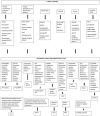Tauopathy and Movement Disorders-Unveiling the Chameleons and Mimics
- PMID: 33250855
- PMCID: PMC7674803
- DOI: 10.3389/fneur.2020.599384
Tauopathy and Movement Disorders-Unveiling the Chameleons and Mimics
Abstract
The spectrum of tauopathy encompasses heterogenous group of neurodegenerative disorders characterized by neural or glial deposition of pathological protein tau. Clinically they can present as cognitive syndromes, movement disorders, motor neuron disease, or mixed. The heterogeneity in clinical presentation, genetic background, and underlying pathology make it difficult to classify and clinically approach tauopathy. In the literature, tauopathies are thus mostly highlighted from pathological perspective. From clinical standpoint, cognitive syndromes are often been focussed while reviewing tauopathies. However, the spectrum of tauopathy has also evolved significantly in the domain of movement disorders and has transgressed beyond the domain of primary tauopathies. Secondary tauopathies from neuroinflammation or autoimmune insults and some other "novel" tauopathies are increasingly being reported in the current literature, while some of them are geographically isolated. Because of the overlapping clinical phenotypes, it often becomes difficult for the clinician to diagnose them clinically and have to wait for the pathological confirmation by autopsy. However, each of these tauopathies has some clinical and radiological signatures those can help in clinical diagnosis and targeted genetic testing. In this review, we have exposed the heterogeneity of tauopathy from a movement disorder perspective and have provided a clinical approach to diagnose them ante mortem before confirmatory autopsy. Additionally, phenotypic variability of these disorders (chameleons) and the look-alikes (mimics) have been discussed with potential clinical pointers for each of them. The review provides a framework within which new and as yet undiscovered entities can be classified in the future.
Keywords: MAPT; chameleons; mimics; movement disorders; tauopathy.
Copyright © 2020 Ganguly and Jog.
Figures
Similar articles
-
Tauopathies as clinicopathological entities.Parkinsonism Relat Disord. 2016 Jan;22 Suppl 1(0 1):S29-33. doi: 10.1016/j.parkreldis.2015.09.020. Epub 2015 Sep 8. Parkinsonism Relat Disord. 2016. PMID: 26382841 Free PMC article. Review.
-
Invited review: Neuropathology of tauopathies: principles and practice.Neuropathol Appl Neurobiol. 2015 Feb;41(1):3-23. doi: 10.1111/nan.12208. Neuropathol Appl Neurobiol. 2015. PMID: 25495175 Review.
-
Tauopathies.Handb Clin Neurol. 2017;145:355-368. doi: 10.1016/B978-0-12-802395-2.00025-0. Handb Clin Neurol. 2017. PMID: 28987182 Review.
-
Tau exhibits unique seeding properties in globular glial tauopathy.Acta Neuropathol Commun. 2019 Mar 7;7(1):36. doi: 10.1186/s40478-019-0691-9. Acta Neuropathol Commun. 2019. PMID: 30845985 Free PMC article.
-
Tau Interacting Proteins: Gaining Insight into the Roles of Tau in Health and Disease.Adv Exp Med Biol. 2019;1184:145-166. doi: 10.1007/978-981-32-9358-8_13. Adv Exp Med Biol. 2019. PMID: 32096036 Review.
Cited by
-
Diagnostic Spectrum in an "Atypical" Atypical Parkinsonism Syndrome Cohort: A Single Center Experience.J Mov Disord. 2025 Jul;18(3):208-212. doi: 10.14802/jmd.25021. Epub 2025 May 7. J Mov Disord. 2025. PMID: 40328430 Free PMC article. No abstract available.
-
Uric Acid, the End-Product of Purine Metabolism, Mitigates Tau-Related Abnormalities: Comparison with DOT, a Non-Antibiotic Oxytetracycline Derivative.Biomolecules. 2025 Jun 28;15(7):941. doi: 10.3390/biom15070941. Biomolecules. 2025. PMID: 40723813 Free PMC article.
-
Vibrotactile stimulation at gamma frequency mitigates pathology related to neurodegeneration and improves motor function.Front Aging Neurosci. 2023 May 18;15:1129510. doi: 10.3389/fnagi.2023.1129510. eCollection 2023. Front Aging Neurosci. 2023. PMID: 37273653 Free PMC article.
-
Jatamansinol from Nardostachys jatamansi Ameliorates Tau-Induced Neurotoxicity in Drosophila Alzheimer's Disease Model.Mol Neurobiol. 2022 Oct;59(10):6091-6106. doi: 10.1007/s12035-022-02964-7. Epub 2022 Jul 22. Mol Neurobiol. 2022. PMID: 35864434
-
Understanding the contributions of VPS35 and the retromer in neurodegenerative disease.Neurobiol Dis. 2022 Aug;170:105768. doi: 10.1016/j.nbd.2022.105768. Epub 2022 May 16. Neurobiol Dis. 2022. PMID: 35588987 Free PMC article. Review.
References
Publication types
LinkOut - more resources
Full Text Sources



